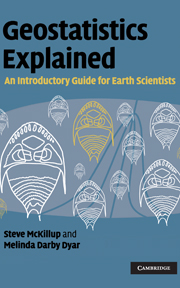Book contents
- Frontmatter
- Contents
- Preface
- 1 Introduction
- 2 “Doing science”: hypotheses, experiments and disproof
- 3 Collecting and displaying data
- 4 Introductory concepts of experimental design
- 5 Doing science responsibly and ethically
- 6 Probability helps you make a decision about your results
- 7 Working from samples: data, populations and statistics
- 8 Normal distributions: tests for comparing the means of one and two samples
- 9 Type 1 and Type 2 error, power and sample size
- 10 Single-factor analysis of variance
- 11 Multiple comparisons after ANOVA
- 12 Two-factor analysis of variance
- 13 Important assumptions of analysis of variance, transformations and a test for equality of variances
- 14 Two-factor analysis of variance without replication, and nested analysis of variance
- 15 Relationships between variables: linear correlation and linear regression
- 16 Linear regression
- 17 Non-parametric statistics
- 18 Non-parametric tests for nominal scale data
- 19 Non-parametric tests for ratio, interval or ordinal scale data
- 20 Introductory concepts of multivariate analysis
- 21 Introductory concepts of sequence analysis
- 22 Introductory concepts of spatial analysis
- 23 Choosing a test
- Appendices
- References
- Index
12 - Two-factor analysis of variance
Published online by Cambridge University Press: 05 June 2012
- Frontmatter
- Contents
- Preface
- 1 Introduction
- 2 “Doing science”: hypotheses, experiments and disproof
- 3 Collecting and displaying data
- 4 Introductory concepts of experimental design
- 5 Doing science responsibly and ethically
- 6 Probability helps you make a decision about your results
- 7 Working from samples: data, populations and statistics
- 8 Normal distributions: tests for comparing the means of one and two samples
- 9 Type 1 and Type 2 error, power and sample size
- 10 Single-factor analysis of variance
- 11 Multiple comparisons after ANOVA
- 12 Two-factor analysis of variance
- 13 Important assumptions of analysis of variance, transformations and a test for equality of variances
- 14 Two-factor analysis of variance without replication, and nested analysis of variance
- 15 Relationships between variables: linear correlation and linear regression
- 16 Linear regression
- 17 Non-parametric statistics
- 18 Non-parametric tests for nominal scale data
- 19 Non-parametric tests for ratio, interval or ordinal scale data
- 20 Introductory concepts of multivariate analysis
- 21 Introductory concepts of sequence analysis
- 22 Introductory concepts of spatial analysis
- 23 Choosing a test
- Appendices
- References
- Index
Summary
Introduction
A single-factor ANOVA gives the probability that two or more sample means have come from populations with the same mean (Chapter 10), but can only be used to analyze univariate data from samples exposed to different levels or aspects of only one factor. For example, it could be used to compare the diffusivity of hydrogen through olivine (the variable) at two or more temperatures (the factor), the percentage of feldspar crystals (the variable) in successive layers of an intrusive complex (the factor), or the salinity of seawater (the variable) from several different depths (the factor).
Often, however, scientists obtain univariate data in relation to more than one factor. Examples of two-factor experiments are the phase equilibrium of aluminosilicates (Al2SiO5) at several combinations of temperature and pressure, the growth of crystals as a function of magmatic H2O and cooling rate, or the likelihood of snow as a function of varying humidity levels and temperatures.
It would be very useful to have an analysis that gave separate F ratios (and the probability that the treatment means had come from populations with the same mean) for each of the two factors. That is what two-factor ANOVA does.
Why do an experiment with more than one factor?
Experiments that simultaneously include the effects of more than one factor on a particular variable may be far more revealing than looking at each factor separately because you may detect certain combinations of factors that have a synergistic effect.
- Type
- Chapter
- Information
- Geostatistics ExplainedAn Introductory Guide for Earth Scientists, pp. 142 - 165Publisher: Cambridge University PressPrint publication year: 2010



